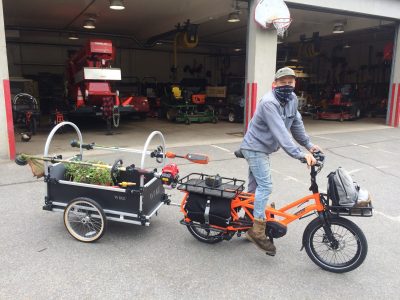
Visitors this summer will notice a few improvements to bicycle infrastructure in our landscape. Although these changes have been in the works for months, improving accessibility for cyclists could not have come at a better time due to a pandemic-associated increase of bike purchases and riders citywide. As more and more people rely on bikes for leisure, exercise, and transportation, the Arboretum is committed to providing a safe and accessible venue for responsible cyclists to enjoy our expansive collections.
A very positive change for the public is the forthcoming installation of new and improved bike racks throughout our grounds. Over the next few months, cyclists can expect to see newer, more secure designs. They will replace and add to the Arboretum’s current single bike rack, located inside the Arborway entrance. Additional bike parking will be installed just past the Hunnewell Visitor Center as well as at several other popular points in the landscape.

These new bike racks will give visitors more flexibility to explore the Arboretum first by bike and then to venture further by foot. This follows the spirit, if not the letter, of our founding director Charles Sprague Sargent’s proposal that “a visitor driving through the Arboretum… be able to obtain a general idea of the arborescent vegetation of the north temperate zone without even leaving his [horse drawn] carriage”. Although it is anyone’s guess whether Sargent would have approved of cycling, it is safe to say he would be happy that his planting methodology nonetheless offers our modern day carriage riders similar convenience and pleasure.
In addition to the bike racks, visitors may notice Arboretum horticultural staff increasingly utilizing bikes for work. The Arboretum recently acquired three Tern GSD electric cargo bikes, designed to carry over 400 pounds of cargo. They are highly adjustable and an excellent match for the varying height and riding requirements of our full time staff and seasonal employees. These cargo bikes can also be coupled with trailers for a combination capable of transporting all of the equipment our grounds staff requires for a day’s work.

The goal of these electric bikes is primarily to provide staff with a more sustainable (and healthier) transportation option than our heavy diesel trucks or light utility vehicles. Advances in battery technology mean our cargo bikes can carry staff for a over a week before recharging, drastically reducing associated greenhouse emissions compared to other transportation options. They will also hopefully improve the visitor experience by reducing the number (and associated noise and physical footprint) of large trucks on the Arboretum’s roads. If the new bikes prove useful, additional styles of cargo bikes and trikes might join the equipment fleet over the coming years.
If you are considering cycling at the Arboretum this summer, please note that cyclists must observe the rules and regulations posted at all entrances. Remember to keep your speed below 10 miles per hour, especially when descending hills, for the safety of all our visitors. Our roads, used by pedestrians of all ages, are not designed to accommodate high speed rides.
Similarly, the Arboretum’s plant collections are not designed for off-road cycling. Although it may seem a small thing, riding across lawns and through the landscape causes soil compaction and rutting, potentially damaging our valuable plants. Finally, out of respect for all who use the landscape, cyclists must wear face coverings and maintain 10 foot physical distancing from other visitors while riding in the Arboretum.
The Arboretum is looking forward to better accommodating bike usage on the grounds this season. We encourage visitors to walk or bike to the landscape while parking is restricted and to consider doing so (if possible) even when parking spaces reopen. Cycling is a healthy and environmentally friendly way to enjoy the landscape; we hope to see more modern day carriage riders in the summer months to come.